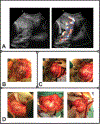Placenta Accreta Spectrum
- PMID: 37290094
- PMCID: PMC10491415
- DOI: 10.1097/AOG.0000000000005229
Placenta Accreta Spectrum
Abstract
Placenta accreta spectrum (PAS) is one of the most dangerous conditions in pregnancy and is increasing in frequency. The risk of life-threatening bleeding is present throughout pregnancy but is particularly high at the time of delivery. Although the exact cause is unknown, the result is clear: Severe PAS distorts the uterus and surrounding anatomy and transforms the pelvis into an extremely high-flow vascular state. Screening for risk factors and assessing placental location by antenatal ultrasonography are essential for timely diagnosis. Further evaluation and confirmation of PAS are best performed in referral centers with expertise in antenatal imaging and surgical management of PAS. In the United States, cesarean hysterectomy with the placenta left in situ after delivery of the fetus is the most common treatment for PAS, but even in experienced referral centers, this treatment is often morbid, resulting in prolonged surgery, intraoperative injury to the urinary tract, blood transfusion, and admission to the intensive care unit. Postsurgical complications include high rates of posttraumatic stress disorder, pelvic pain, decreased quality of life, and depression. Team-based, patient-centered, evidence-based care from diagnosis to full recovery is needed to optimally manage this potentially deadly disorder. In a field that has relied mainly on expert opinion, more research is needed to explore alternative treatments and adjunctive surgical approaches to reduce blood loss and postoperative complications.
Copyright © 2023 by the American College of Obstetricians and Gynecologists. Published by Wolters Kluwer Health, Inc. All rights reserved.
Conflict of interest statement
Financial Disclosure Lisa C. Zuckerwise reports money was paid to her institution from Laborie Medical Technologies Corp for an ongoing clinical study unrelated to placenta accreta spectrum. She received payment from Gershon, Willoughby & Getz, LLC, and Huff, Powell & Bailey, LLC for legal expert consulting not related to placenta accreta spectrum. The other authors did not report any potential conflicts of interest.
Figures



References
-
- Morlando M, Schwickert A, Stefanovic V, et al. Maternal and neonatal outcomes in planned versus emergency cesarean delivery for placenta accreta spectrum: A multinational database study. Acta Obstet Gynecol Scand 2021;100 Suppl 1:41–49. doi: 10.1111/aogs.14120 [published Online First: 2021/March/14] - DOI - PubMed
-
- Placenta accreta spectrum. Obstetric Care Consensus No. 7. American College of Obstetricians and Gynecologists. Obstetrics and Gynecology 2018;132:e259–75. - PubMed
MeSH terms
Grants and funding
LinkOut - more resources
Full Text Sources

